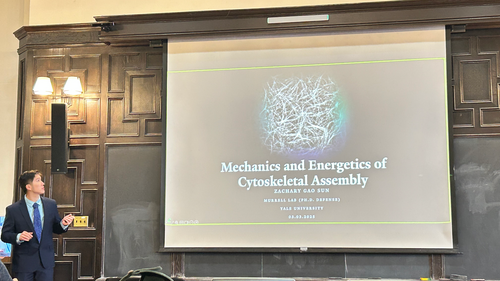
On March 3, 2025, Zachary Sun successfully defended the thesis “Mechanics and Energetics of Cytoskeletal Assembly” (advisor: Michael Murrell).
Sun explained, “Active matter is a subfield of soft condensed matter physics that focuses on the emergence of collective phenomena, as components of the system consume energy, driving them out of thermodynamic equilibrium. Living matter, a specific subfield of active matter, lies between physics and biology.An example of a driven, non-equilibrium thermodynamic system is the cell cytoskeleton, which is an exquisite machinery that is responsible for complex tasks such as migration and division. The protein scaffolding of the cell (F-actin) undergoes dramatic changes in structure, organization, and dynamics through impartation of mechanical stresses by molecular motors (myosin) which consume chemical energy during these morphological changes. However, how the consumption of chemical energy drives the mechanical performance of biological, protein-based machines is unknown.We use the bottom-up approach and assemble the biomimetic cytoskeletal structure, the actomyosin network, using minimalistic purified protein components (in vitro).My thesis focuses on challenging the current understanding of the cytoskeleton field from a more network-focused perspective and motivates the investigation of how a cell regulates its energetic efficiency as an out-of-equilibrium thermodynamic machine.”
Thesis Abstract:
Living matter, a specific subfield of active matter, lies between physics and biology. An example of a driven, non-equilibrium thermodynamic system is the cell cytoskeleton. It is composed of proteins and other biological macromolecules which interact to yield collective behaviors. For example, the protein scaffolding of the cell (F-actin) undergoes dramatic changes in structure, organization, and dynamics through impartation of mechanical stresses by molecular motors (myosin) which consume chemical energy during these morphological changes. However, how the consumption of chemical energy drives the mechanical performance of biological, protein-based machines is unknown. We use the bottom-up approach and assemble the biomimetic cytoskeletal structure, the actomyosin network, using minimalistic purified protein components (in vitro). I will summarize several aspects related to the active mechanics and energetics of the cytoskeletal assembly such as how material properties relate to chemical consumption and vice versa. In doing so, I will describe unique aspects of non-equilibrium materials, including active stress propagation, energy consumption and dissipation, self-tuned critical behaviors, novel constitutive relationships, emergence of spatiotemporal instabilities (in vitro actin waves), and the change in heat dissipation and energetic efficiency.